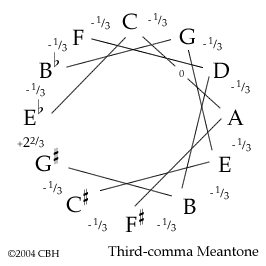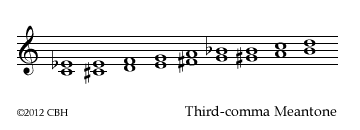Technical Library
TEMPERAMENTS XV: Third-comma Meantone
Entire Contents Copyright © 2013 CBHTechnical LibraryTEMPERAMENTS XV: Third-comma Meantone Entire Contents Copyright © 2013 CBH |
 WIKIMEDIA COMMONS / PUBLIC DOMAIN |
| Francisco de Salinas (1513–1590) |
Just to get you right out of the comfort zone with your quarter-comma familiarity, why not try a temperament discussed some time ago on the HPSCHD-List?
Instead of dividing the four fifths that make up the pure Major third c'–e' interval into resultant quarter-comma narrow fifths, we will now divide a minor third instead. The resultant fifths are a third-comma narrow. All the other notes of the scale will be found by tuning pure minor thirds. Yes, there will be a wolf—Aghast!—even larger than that of our beloved Quarter-comma Meantone. We have nine pure minor thirds, and the usable Major thirds are somewhat smaller than pure. But the piquancy gained is extraordinary, and well worth the concentrated effort.
This temperament was described by the blind Spanish musician Francisco de Salinas (1513–1590) in his De musica libri septem published in Salamanca in 1577, although here I have the wolf in its normal place between G♯ and E♭.
 A
pure minor third is particularly tricky to hear because it is not something that
we are accustomed to. Your ears will need to be focused to try this temperament,
but it is not impossible. To tune successful minor thirds, the lowest coincident
harmonics that you will be listening for—either consciously or not—are
a little higher than any of the temperaments discussed previously: You must be
listening not to the actual notes you are playing, but in fact in the region
two octaves and a fifth above your bottom note. This aside, after your experience
with Quarter-comma Meantone, you’ll find the actual tuning procedure is
remarkably similar.
A
pure minor third is particularly tricky to hear because it is not something that
we are accustomed to. Your ears will need to be focused to try this temperament,
but it is not impossible. To tune successful minor thirds, the lowest coincident
harmonics that you will be listening for—either consciously or not—are
a little higher than any of the temperaments discussed previously: You must be
listening not to the actual notes you are playing, but in fact in the region
two octaves and a fifth above your bottom note. This aside, after your experience
with Quarter-comma Meantone, you’ll find the actual tuning procedure is
remarkably similar.
First we establish the reference point with a tuning fork, then tune the determining interval which we divide equally to produce the size of the fifths. All the other notes of the scale are found by tuning from these first four notes, and then extending around the circle on the sharp side. We will be tuning the desired minor thirds pure, and all the fifths will be narrow by the same amount as a consequence. A fifth tempered by a third-comma is quite a deal smaller than a fifth reduced by a quarter-comma, so be prepared for your fifths to sound proportionally rougher.
Proceed as follows to tune Third-comma Meantone:
1. Tune your c'' to a tuning fork, and tune middle c' and c in absolute perfect tune below it.
2. Tune the a so it is a pure minor third below middle c'.
3. Tune your g pure to tenor c, then lower the g until you can bear the roughness of the fifth no longer: It will do for now. Tune your d below a pure, then sharpen the d until your d–a matches the roughness of c–g. With any luck you are close, and when you tune an octave from d–d', the fifth made by g–d' is particularly coarse and vulgar because of its higher pitch on the keyboard. Juggle your Gs and Ds around until you are happy, because you then have other notes to determine from these.
4. So we don’t get lost, let’s work in chains of diminished chords to fill in the gaps. Find the f♯ a pure minor third below a, and the e♭ a pure minor third above c. (Don’t tune a pure minor third down from your f♯, because that will give you a d♯ when you really want an e♭.)
 5. From your g, find the b♭ which is a perfect minor
third above, followed by the e a pure minor third below g, and
then the c♯ which is a pure minor third below that e.
5. From your g, find the b♭ which is a perfect minor
third above, followed by the e a pure minor third below g, and
then the c♯ which is a pure minor third below that e.
6. From your d', find the b which is a pure minor third below, followed by the g♯ a pure minor third below that b. Finally, you must find your f a pure minor third above d. (Again, don’t be tempted to tune a pure minor third down from your g♯, unless you want to get an e♯, of all things.)
7. All the notes of the scale are now determined, but because of the difficulty of hearing these unfamiliar minor thirds, a little checking will not go astray. Fortunately the fifths are all the same, harsh size of a third-comma, and if you compare the chains of fifths as you ascend the keyboard, you can verify that each one beats slightly faster than the previous: c–g, d–a, e♭–b♭, e–b, f–c', f♯–c♯', g–d', a–e', b♭–f', and b–f♯'. Last of all, try the wolf g♯–e♭', and see why this is definitely an interval to avoid.
And play some music: Minor keys are de rigueur here, thanks.
Further discussion
Anonymous [Kayano, Moxzan] Dodecagon — Chi-s akt temo Tokyo 2012, p58
Veroli, Claudio di Unequal Temperaments Artes Graficas Farro, Buenos Aires 1978, p60
| Pitch nomenclature | |
| Harpsichord Tuning Process | |
| Tuning Bibliography | |
| Technical Library overview | |
| Harpsichords Australia Home Page |